Item 1: Report to Shareholders| Short-Term Bond Fund | November 30, 2005 |
The views and opinions in this report were current as of November 30, 2005. They are not guarantees of performance or investment results and should not be taken as investment advice. Investment decisions reflect a variety of factors, and the managers reserve the right to change their views about individual stocks, sectors, and the markets at any time. As a result, the views expressed should not be relied upon as a forecast of the fund’s future investment intent. The report is certified under the Sarbanes-Oxley Act of 2002, which requires mutual funds and other public companies to affirm that, to the best of their knowledge, the information in their financial reports is fairly and accurately stated in all material respects.
REPORTS ON THE WEB
Sign up for our E-mail Program, and you can begin to receive updated fund reports and prospectuses online rather than through the mail. Log in to your account at troweprice.com for more information.
Fellow Shareholders
Short-term bonds eked out a small gain during the six months ended November 30, 2005, in a challenging environment for fixed-income securities. Rising interest rates throughout most of the period put downward pressure on bond prices as yields rose across all maturities. Your fund produced modest gains during the recent reporting period and over the past 12 months as income offset a decline in net asset value.
MARKET ENVIRONMENT
President George W. Bush announced his replacement for Federal Reserve Chairman Alan Greenspan when his term expires early next year. If he is confirmed by the Senate as expected, Ben S. Bernanke will follow in Greenspan's footsteps and is expected to continue his policies. ?My first priority will be to maintain continuity with the policies and policy strategies established during the Greenspan years,? Bernanke said during a joint press conference with the president. Bernanke currently serves as chairman of President Bush’s Council of Economic Advisers. Since the persistence of strong economic growth continues to put upward pressure on inflation, the Bernanke Fed is likely to continue raising short-term interest rates a while longer to prevent inflation from spiraling out of control. (See sidebar on page 2.)
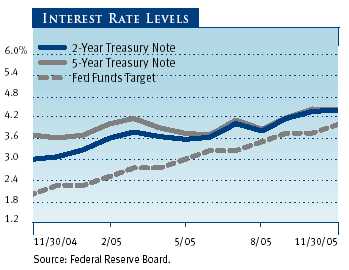
The economy continues to be fueled by consumer spending, supported by a brisk rise in income. The data suggest that the economy has safely weathered the combined forces of several hurricanes that devastated wide swaths of the southern U.S. Indeed, third-quarter economic growth was measured at an impressive 4.3%, stronger than most observers had expected, and unemployment stood at 5.0% at the end of November, down from 5.1% in August. The Fed raised short-term rates another quarter-point to 4.25% on December 13, after the close of the reporting period, its 13th interest rate hike since June 2004. With just six weeks left before he leaves office, Fed Chairman Alan Greenspan raised a red flag by warning Congress that the country could face ?serious economic disruptions? if the federal government's bloated budget deficit is not curbed.
| THE FED’S ROLE AND WHAT IT MEANS TO YOU |
After the January 31, 2006, Federal Open Market Committee (FOMC) meeting, Chairman Alan Greenspan will retire. His successor will be Ben S. Bernanke, currently the chairman of President Bush’s Council of Economic Advisers, and former Fed governor and Princeton professor. Mary Miller, director of T. Rowe Price’s Fixed Income Division, says, ?For 18 years Alan Greenspan has been a steady hand at the Fed's helm, guiding us through volatile financial markets and geopolitical events with sound reasoning and long-term perspective. His inflation-fighting resolve has structurally lowered inflation expectations, leading to milder business cycles and greater prosperity.?
Why should you care about the Fed’s moves or Greenspan’s successor? The short answer is the central bank’s actions—including setting monetary policy and overseeing the integrity of the banking system—impact mortgage rates, credit card costs, and fixed-income yields. At the most visible level, the Fed raises short-term interest rates to curb inflation when the economy is growing quickly and lowers them when it wants to stimulate economic growth. The chart below shows the FOMC systematically lowering rates in 2001 as the economy slipped into recession following the implosion of the dot-com bubble. Once the economy gained traction, the Fed started raising the fed funds rate. The stairstep increases from mid-2004 to date have had the desired effect of slowing GDP growth while keeping inflation from accelerating. Most credit-market experts correctly anticipated the December 13 rate increase and expect another quarter-point rate hike at the January 31 FOMC meeting.
Miller thinks that Bernanke’s monetary policy should dovetail seamlessly with Greenspan’s. In his statement to the Senate Banking Committee, Bernanke affirmed, ?under Greenspan, monetary policy has become increasingly transparent to the public and financial markets, a trend I strongly support.? This focus, in Miller’s view, is a positive for credit-market stability. She added, ?The incoming chairman's pledge to target the inflation level he considers consistent with long-term price stability is not a departure from present practices and should continue to benefit fixed-income investors.?
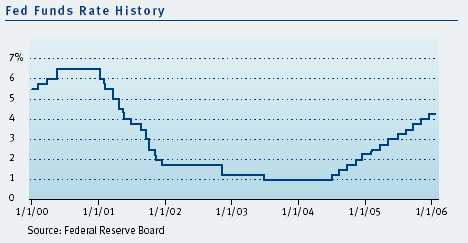
The gap in yields between bonds with short and long maturities tightened further. At the end of November, the yield differential between two- and five-year Treasuries had completely evaporated, and 30-year Treasury yields were just three-tenths of a percentage point higher. (Bond prices and yields move in opposite directions.) The so-called yield curve, which depicts the relationship among bonds with varying maturities, has been flattening since the Fed began raising short-term rates in June 2004.
PERFORMANCE
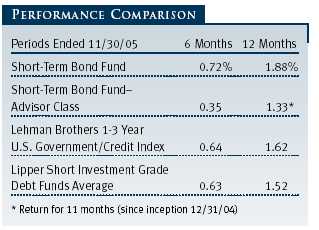
Your fund generated slim gains during the 6- and 12-month periods ended November 30, 2005, surpassing the Lehman Brothers 1-3 Year U.S. Government/Credit Index and the Lipper peer group average over both periods. (Advisor Class shares commenced operations on December 31, 2004, as mentioned in our last report, so the longer-term performance shown in the table is for only 11 months. Six-month results were lower than the fund’s, reflecting the Advisor Class’s higher expense ratio.) The fund’s net asset value declined $0.05 from the end of May to $4.68 at the end of November in a difficult environment, but dividends contributed $0.08 per share, resulting in a positive total return for the six-month period. For the 12-month cycle, the net asset value fell $0.07 but dividends amounting to $0.16 per share put the annual return in positive territory. As you know, the objective of the fund is to provide greater income than is available from a money market fund, but with a higher degree of principal risk.
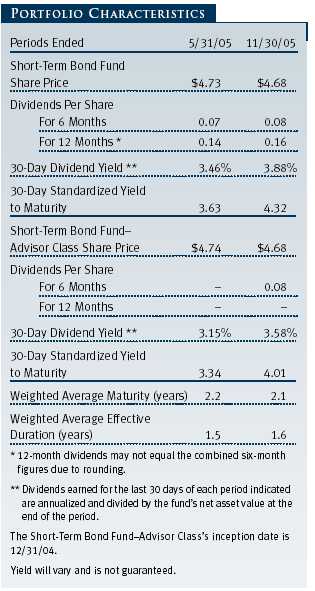
During the past six months, we kept the portfolio’s duration roughly neutral versus the Lehman Brothers benchmark (duration is a measure of a portfolio’s sensitivity to changes in interest rates; see the glossary following this letter for a more detailed explanation). We also maintained a barbell structure in the portfolio, concentrating on securities with short and longer maturities, particularly overweighting the longer-term maturities. This strategy helped enhance the fund’s relative performance as the yield curve flattened throughout the period.
Regarding sector allocations, we maintained an overweight in mortgage-backed bonds, which also added to fund results. Asian demand for mortgage bonds remains high and relative valuations are attractive, but we have grown cautious on this sector due to the flattening yield curve and the sector’s potential for higher volatility.
We maintained our weighting in asset-backed securities; the sector has remained fairly stable in an uncertain environment due to supply factors and weakness in the automobile industry. The bonds we have been purchasing are rated BBB and offer an attractive yield in a sector with generally steep valuations. These holdings have benefited from strong technical demand that continued to drive performance. In addition, we trimmed our exposure to the corporate sector slightly, focusing on securities that offered opportunities for diversification. The sector has some risks, including the potential for share buy-backs, one-time dividend payouts, and merger and acquisition activity—all of which could have a negative impact on corporates. While we still favor lower-quality credits in this area, the available selection has grown increasingly limited.
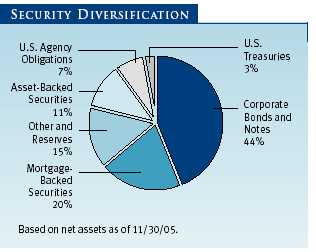
At the end of November, 20% of the portfolio was allocated to AAA securities, 21% to agencies (including GNMAs and collateralized mortgage obligations), 11% to AA, 15% to A, 18% to BBB, only 1% to BB and below, and the balance to reserves. Corporate bonds and notes amounted to 44% of portfolio net assets, mortgage-backed securities 21%, asset-backed securities 10%, and the remaining 25% was divided primarily among U.S. Treasuries, agency obligations, and reserves.
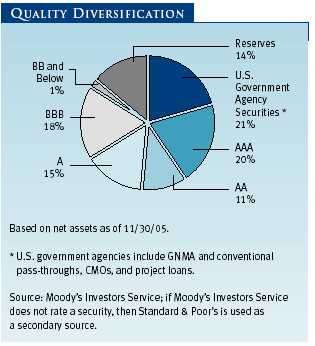
OUTLOOK
Energy costs have moderated from the levels reached in the wake of the Gulf Coast hurricanes but still remain high. Nevertheless, we do not expect energy product shortages or sector uncertainty to crimp planned business activity. The Bernanke Fed is likely to continue with a measured pace of short-term rate hikes until the employment rate and inflation have stabilized. As signs emerge that the U.S. central bank is nearing the end of the tightening cycle, we will look to modestly extend the duration of the fund, but in the near term we expect to maintain a neutral posture versus the benchmark.
Short-term fixed-income securities, with their lower volatility than long-term bonds, provide good diversification in a fixed-income portfolio. They generate income that can help offset losses in principal and provide a relatively safe haven during periods of geopolitical instability. While securities across the entire spectrum of maturities (except for money market securities) are likely to feel the pressure of rising interest rates in coming months, the next round of tightening is already discounted to some extent in current valuations. Accordingly, we believe short-term bonds should be able to withstand the impact of any future rate hikes as long as they come at the measured pace of the past 17 months.
As always, we will continue to monitor conditions closely and look for opportunities as they become available in a changing economic environment.
Thank you for investing with T. Rowe Price.
Respectfully submitted,

Edward A. Wiese
President and chairman of the fund’s Investment Advisory Committee
December 16, 2005
The committee chairman has day-to-day responsibility for managing the portfolio and works with committee members in developing and executing the fund’s investment program.
RISKS OF FIXED-INCOME INVESTING
Bonds are subject to interest rate risk (the decline in bond prices that usually accompanies a rise in interest rates) and credit risk (the chance that any fund holding could have its credit rating downgraded, or that a bond issuer will default by failing to make timely payments of interest or principal), potentially reducing the fund’s income level and share price. Mortgage-backed securities are subject to prepayment risk, particularly if falling rates lead to heavy refinancing activity, and extension risk, which is an increase in interest rates that causes a fund’s average maturity to lengthen unexpectedly due to a drop in mortgage prepayments. This could increase the fund’s sensitivity to rising interest rates and its potential for price declines.
GLOSSARY
Fed Funds Rate: The interest rate charged on overnight loans of reserves by one financial institution to another in the United States. The Federal Reserve sets a target federal funds rate to affect the direction of interest rates.
Lipper Averages: The averages of available mutual fund performance returns for specified time periods in defined categories as tracked by Lipper Inc.
Lehman Brothers 1-3 Year U.S. Government/Credit Index: A total return index that incorporates all bonds in both the Treasury Bond Index and the Agency Bond Index, as well as U.S. corporate and some foreign debentures and secured notes, with maturities of one to three years.
Duration: A measure of a bond fund’s sensitivity to changes in interest rates. For example, a fund with a duration of two years would fall about 2% in price in response to a one-percentage-point rise in interest rates, and vice versa.
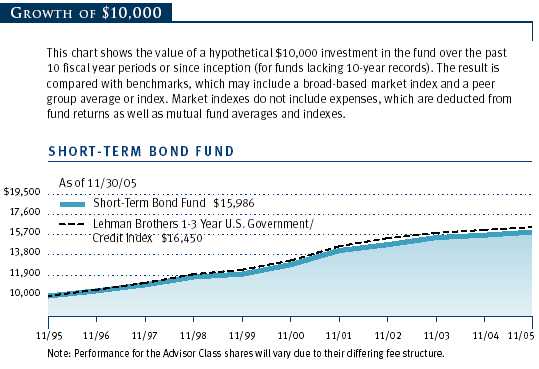

As a mutual fund shareholder, you may incur two types of costs: (1) transaction costs such as redemption fees or sales loads and (2) ongoing costs, including management fees, distribution and service (12b-1) fees, and other fund expenses. The following example is intended to help you understand your ongoing costs (in dollars) of investing in the fund and to compare these costs with the ongoing costs of investing in other mutual funds. The example is based on an investment of $1,000 invested at the beginning of the most recent six-month period and held for the entire period.
Please note that the fund has two share classes: The original share class (“investor class”) charges no distribution and service (12b-1) fee. Advisor Class shares are offered only through unaffiliated brokers and other financial intermediaries and charge a 0.25% 12b-1 fee. Each share class is presented separately in the table.
Actual Expenses
The first line of the following table (“Actual”) provides information about actual account values and expenses based on the fund’s actual returns. You may use the information in this line, together with your account balance, to estimate the expenses that you paid over the period. Simply divide your account value by $1,000 (for example, an $8,600 account value divided by $1,000 = 8.6), then multiply the result by the number in the first line under the heading “Expenses Paid During Period” to estimate the expenses you paid on your account during this period.
Hypothetical Example for Comparison Purposes
The information on the second line of the table (“Hypothetical”) is based on hypothetical account values and expenses derived from the fund’s actual expense ratio and an assumed 5% per year rate of return before expenses (not the fund’s actual return). You may compare the ongoing costs of investing in the fund with other funds by contrasting this 5% hypothetical example and the 5% hypothetical examples that appear in the shareholder reports of the other funds. The hypothetical account values and expenses may not be used to estimate the actual ending account balance or expenses you paid for the period.
Note: T. Rowe Price charges an annual small-account maintenance fee of $10, generally for accounts with less than $2,000 ($500 for UGMA/UTMA). The fee is waived for any investor whose T. Rowe Price mutual fund accounts total $25,000 or more, accounts employing automatic investing, and IRAs and other retirement plan accounts that utilize a prototype plan sponsored by T. Rowe Price (although a separate custodial or administrative fee may apply to such accounts). This fee is not included in the accompanying table. If you are subject to the fee, keep it in mind when you are estimating the ongoing expenses of investing in the fund and when comparing the expenses of this fund with other funds.
You should also be aware that the expenses shown in the table highlight only your ongoing costs and do not reflect any transaction costs, such as redemption fees or sales loads. Therefore, the second line of the table is useful in comparing ongoing costs only and will not help you determine the relative total costs of owning different funds. To the extent a fund charges transaction costs, however, the total cost of owning that fund is higher.
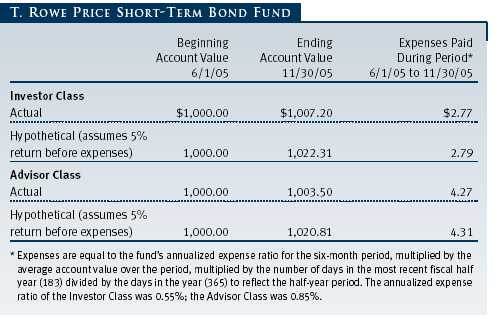
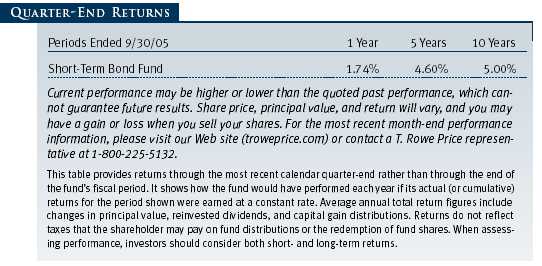
Unaudited
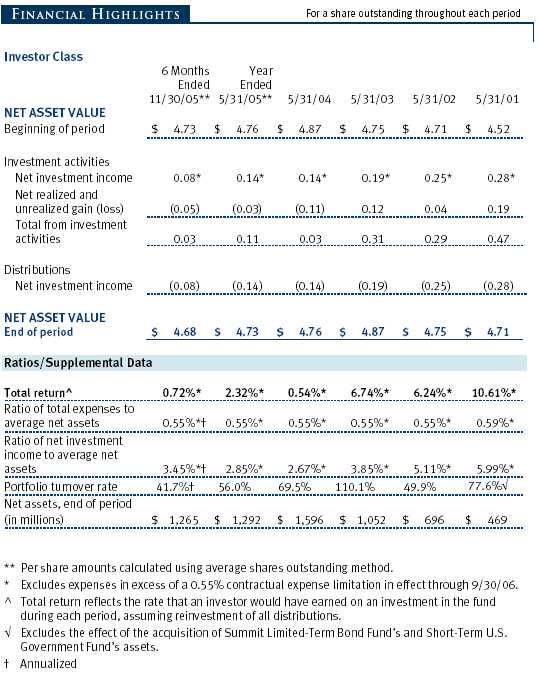
The accompanying notes are an integral part of these financial statements.
Unaudited
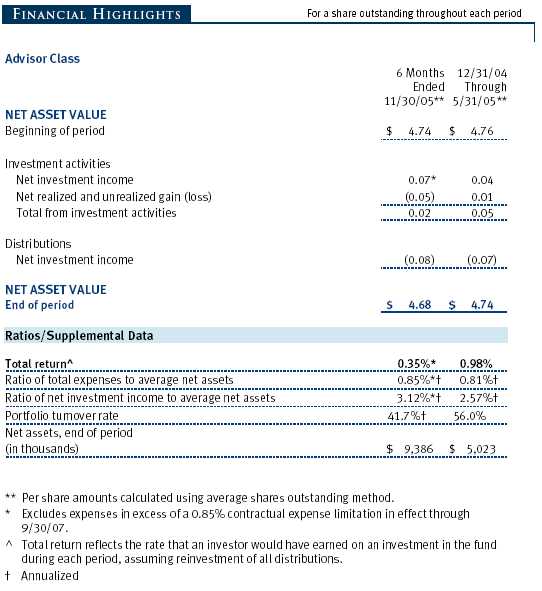
The accompanying notes are an integral part of these financial statements.
Unaudited
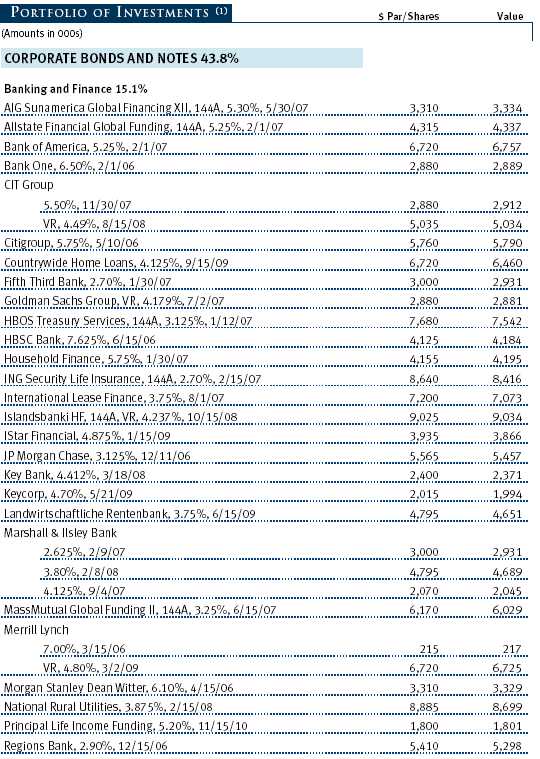
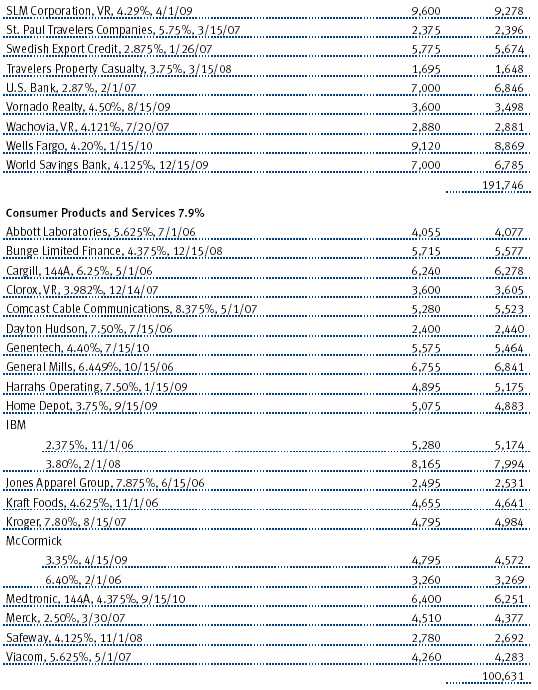
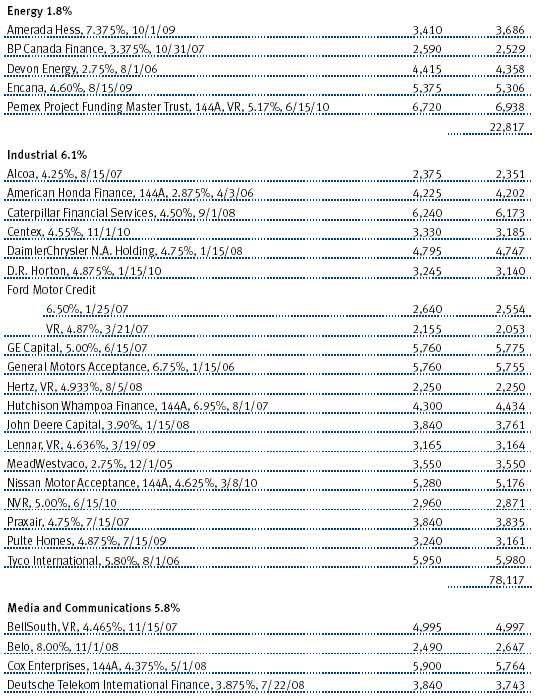

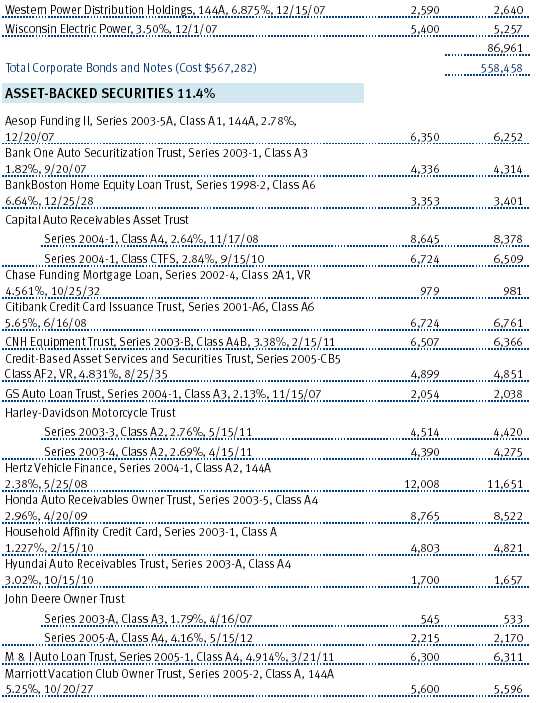
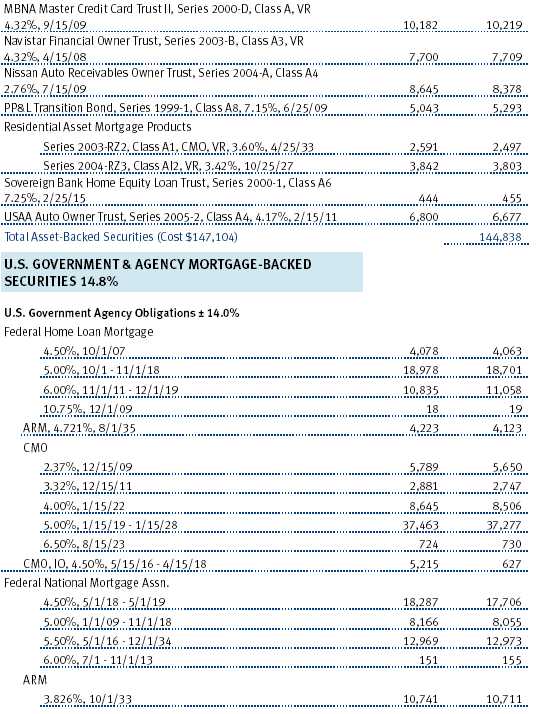
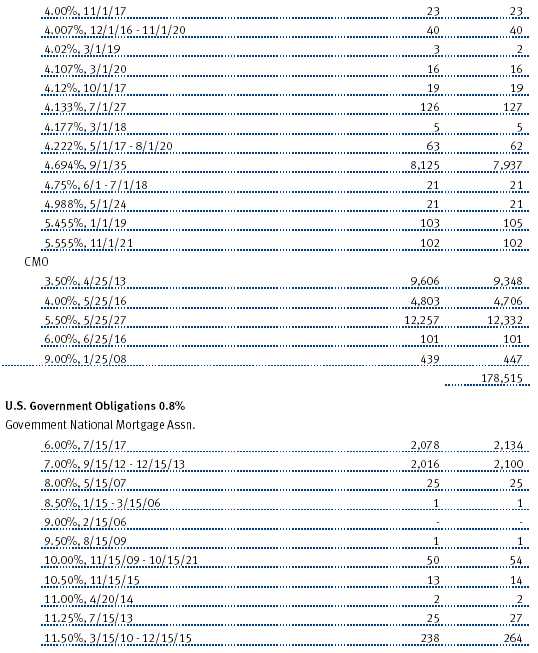
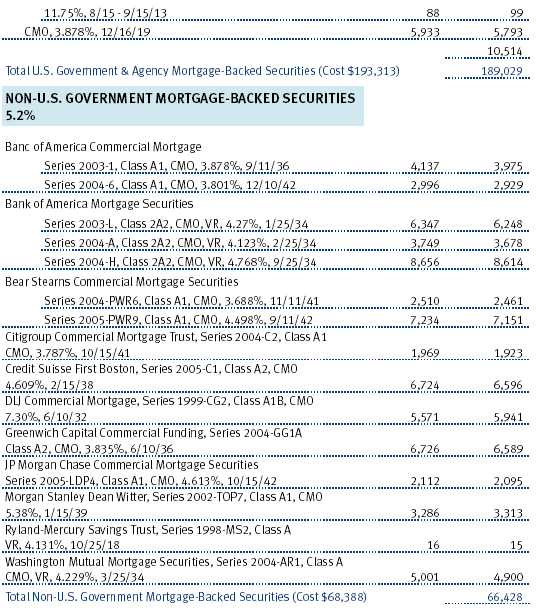
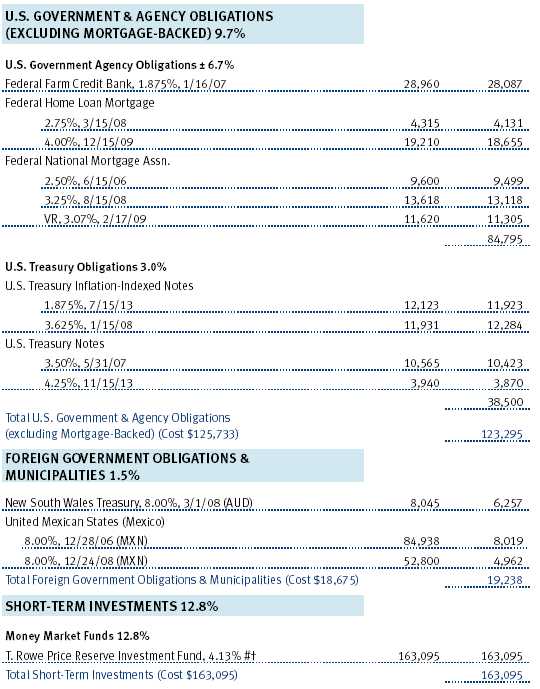

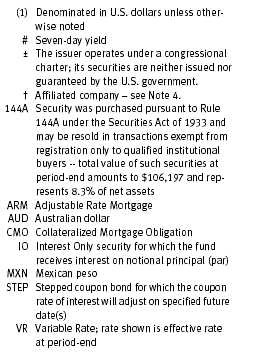
The accompanying notes are an integral part of these financial statements.
Unaudited
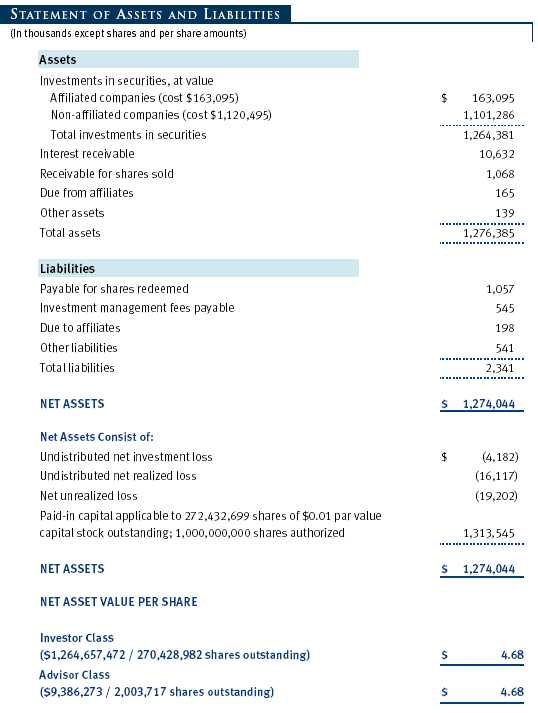
The accompanying notes are an integral part of these financial statements.
Unaudited
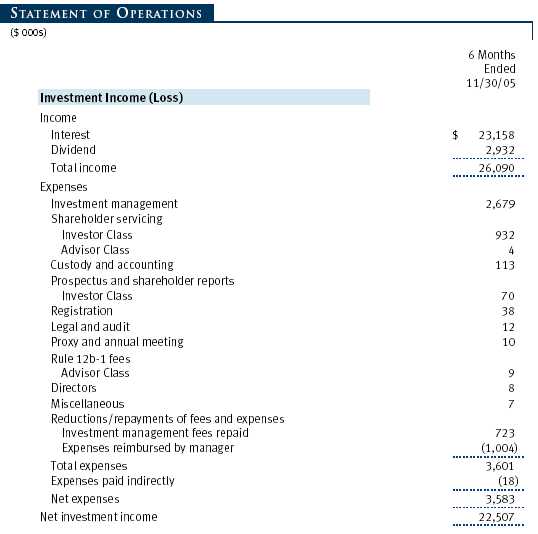
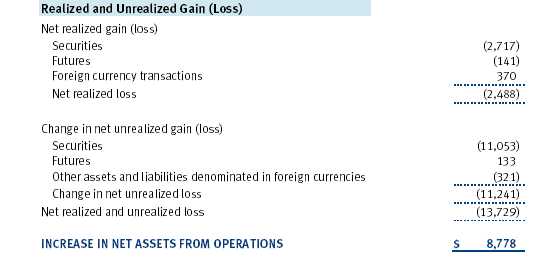
The accompanying notes are an integral part of these financial statements.
Unaudited
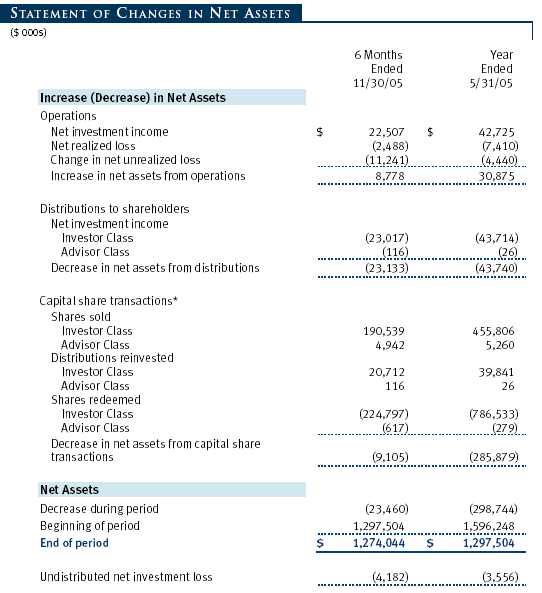

The accompanying notes are an integral part of these financial statements.
Unaudited
| NOTES TO FINANCIAL STATEMENTS |
NOTE 1 - SIGNIFICANT ACCOUNTING POLICIES
T. Rowe Price Short-Term Bond Fund, Inc. (the fund) is registered under the Investment Company Act of 1940 (the 1940 Act) as a diversified, open-end management investment company. The fund seeks a high level of income consistent with minimal fluctuation in principal value and liquidity. The fund has two classes of shares: the Short-Term Bond Fund original share class, referred to in this report as the Investor Class, offered since March 2, 1984, and Short-Term Bond Fund—Advisor Class (Advisor Class), offered since December 31, 2004. Advisor Class shares are sold only through unaffiliated brokers and other unaffiliated financial intermediaries that are compensated by the class for distribution, shareholder servicing, and/or certain administrative services under a Board-approved Rule 12b-1 plan. Each class has exclusive voting rights on matters related solely to that class, separate voting rights on matters that relate to both classes, and, in all other respects, the same rights and obligations as the other class.
The accompanying financial statements were prepared in accordance with accounting principles generally accepted in the United States of America, which require the use of estimates made by fund management. Fund management believes that estimates and security valuations are appropriate; however actual results may differ from those estimates, and the security valuations reflected in the financial statements may differ from the value the fund ultimately realizes upon sale of the securities.
Valuation The fund values its investments and computes its net asset value per share at the close of the New York Stock Exchange (NYSE), normally 4 p.m. ET, each day that the NYSE is open for business. Debt securities are generally traded in the over-the-counter market. Securities with original maturities of one year or more are valued at prices furnished by dealers who make markets in such securities or by an independent pricing service, which considers yield or price of bonds of comparable quality, coupon, maturity, and type, as well as prices quoted by dealers who make markets in such securities. Securities with original maturities of less than one year are stated at fair value, which is determined by using a matrix system that establishes a value for each security based on bid-side money market yields.
Investments in mutual funds are valued at the mutual fund’s closing net asset value per share on the day of valuation. Financial futures contracts are valued at closing settlement prices. Forward currency exchange contracts are valued using the prevailing forward exchange rate.
Other investments, including restricted securities, and those for which the above valuation procedures are inappropriate or are deemed not to reflect fair value are stated at fair value as determined in good faith by the T. Rowe Price Valuation Committee, established by the fund’s Board of Directors.
Most foreign markets close before the close of trading on the NYSE. If the fund determines that developments between the close of a foreign market and the close of the NYSE will, in its judgment, materially affect the value of some or all of its portfolio securities, which in turn will affect the fund’s share price, the fund will adjust the previous closing prices to reflect the fair value of the securities as of the close of the NYSE, as determined in good faith by the T. Rowe Price Valuation Committee, established by the fund’s Board of Directors. A fund may also fair value securities in other situations, such as when a particular foreign market is closed but the fund is open. In deciding whether to make fair value adjustments, the fund reviews a variety of factors, including developments in foreign markets, the performance of U.S. securities markets, and the performance of instruments trading in U.S. markets that represent foreign securities and baskets of foreign securities. The fund uses outside pricing services to provide it with closing market prices and information used for adjusting those prices. The fund cannot predict when and how often it will use closing prices and when it will adjust those prices to reflect fair value. As a means of evaluating its fair value process, the fund routinely compares closing market prices, the next day’s opening prices in the same markets, and adjusted prices.
Currency Translation Assets, including investments, and liabilities denominated in foreign currencies are translated into U.S. dollar values each day at the prevailing exchange rate, using the mean of the bid and asked prices of such currencies against U.S. dollars as quoted by a major bank. Purchases and sales of securities, income, and expenses are translated into U.S. dollars at the prevailing exchange rate on the date of the transaction. The effect of changes in foreign currency exchange rates on realized and unrealized security gains and losses is reflected as a component of security gains and losses.
Class Accounting The Advisor Class pays distribution, shareholder servicing, and/or certain administrative expenses in the form of Rule 12b-1 fees, in an amount not exceeding 0.25% of the class’s average daily net assets. Shareholder servicing, prospectus, and shareholder report expenses incurred by each class are charged directly to the class to which they relate. Expenses common to both classes and investment income are allocated to the classes based upon the relative daily net assets of each class’s settled shares; realized and unrealized gains and losses are allocated based upon the relative daily net assets of each class’s outstanding shares.
Credits The fund earns credits on temporarily uninvested cash balances at the custodian that reduce the fund’s custody charges. Custody expense in the accompanying financial statements is presented before reduction for credits, which are reflected as expenses paid indirectly.
In-Kind Redemptions In certain circumstances, the fund may distribute portfolio securities rather than cash as payment for a redemption of fund shares (in-kind redemption). For financial reporting purposes, the fund recognizes a gain on in-kind redemptions to the extent the value of the distributed securities on the date of redemption exceeds the cost of those securities; the fund recognizes a loss if cost exceeds value. Gains and losses realized on in-kind redemptions are not recognized for tax purposes, and are reclassified from undistributed realized gain (loss) to paid-in capital. During the six months ended November 30, 2005, the fund realized $845,000 of net loss on $43,070,000 of in-kind redemptions.
Investment Transactions, Investment Income, and Distributions Income and expenses are recorded on the accrual basis. Premiums and discounts on debt securities are amortized for financial reporting purposes. Inflation adjustments to the principal amount of inflation-indexed bonds are included in interest income. Dividends received from mutual fund investments are reflected as dividend income; capital gain distributions are reflected as realized gain/loss. Dividend income and capital gain distributions are recorded on the ex-dividend date. Investment transactions are accounted for on the trade date. Realized gains and losses are reported on the identified cost basis. Payments (“variation margin”) made or received to settle the daily fluctuations in the value of futures contracts are recorded as unrealized gains or losses until the contracts are closed. Paydown gains and losses are recorded as an adjustment to interest income. Distributions to shareholders are recorded on the ex-dividend date. Income distributions are declared by each class on a daily basis and paid monthly. Capital gain distributions, if any, are declared and paid by the fund, typically on an annual basis.
NOTE 2 - INVESTMENT TRANSACTIONS
Consistent with its investment objective, the fund engages in the following practices to manage exposure to certain risks or enhance performance. The investment objective, policies, program, and risk factors of the fund are described more fully in the fund’s prospectus and Statement of Additional Information.
Restricted Securities The fund may invest in securities that are subject to legal or contractual restrictions on resale. Although certain of these securities may be readily sold, for example, under Rule 144A, others may be illiquid, their sale may involve substantial delays and additional costs, and prompt sale at an acceptable price may be difficult.
Forward Currency Exchange Contracts During the six months ended November 30, 2005, the fund was a party to forward currency exchange contracts under which it is obligated to exchange currencies at specified future dates and exchange rates. Risks arise from the possible inability of counterparties to meet the terms of their agreements and from movements in currency values.
Futures Contracts During the six months ended November 30, 2005, the fund was a party to futures contracts, which provide for the future sale by one party and purchase by another of a specified amount of a specific financial instrument at an agreed upon price, date, time, and place. Risks arise from possible illiquidity of the futures market and from movements in security values and/or interest rates.
TBA Purchase Commitments During the six months ended November 30, 2005, the fund entered into TBA (to be announced) purchase commitments, pursuant to which it agrees to purchase mortgage-backed securities for a fixed unit price, with payment and delivery at a scheduled future date beyond the customary settlement period for that security. With TBA transactions, the particular securities to be delivered are not identified at trade date; however, delivered securities must meet specified terms, including issuer, rate, and mortgage term, and be within industry-accepted “good delivery” standards. The fund generally enters into TBAs with the intention of taking possession of the underlying mortgage securities. Until settlement, the fund maintains cash reserves and liquid assets sufficient to settle its TBAs.
Dollar Rolls During the six months ended November 30, 2005, the fund entered into dollar roll transactions, pursuant to which it sells a mortgage-backed TBA or security and simultaneously purchases a similar, but not identical, TBA with the same issuer, rate, and terms. The fund may execute a “roll” to obtain better underlying mortgage securities or to enhance returns. The fund generally enters into dollar roll transactions with the intention of taking possession of the underlying mortgage securities, but may close a contract prior to settlement or “roll” settlement to a later date if deemed in the best interest of shareholders. Actual mortgages received by the fund may be less favorable than those anticipated. The fund accounts for dollar roll transactions as purchases and sales, which has the effect of increasing its portfolio turnover rate.
Other Purchases and sales of portfolio securities, other than short-term and U.S. government securities, aggregated $159,614,000 and $217,781,000, respectively, for the six months ended November 30, 2005. Purchases and sales of U.S. government securities aggregated $77,519,000 and $89,258,000, respectively, for the six months ended November 30, 2005.
NOTE 3 - FEDERAL INCOME TAXES
No provision for federal income taxes is required since the fund intends to continue to qualify as a regulated investment company under Subchapter M of the Internal Revenue Code and distribute to shareholders all of its taxable income and gains. Federal income tax regulations differ from generally accepted accounting principles; therefore, distributions determined in accordance with tax regulations may differ in amount or character from net investment income and realized gains for financial reporting purposes. Financial reporting records are adjusted for permanent book/tax differences to reflect tax character. Financial records are not adjusted for temporary differences. The amount and character of tax-basis distributions and composition of net assets are finalized at fiscal year-end; accordingly, tax-basis balances have not been determined as of November 30, 2005.
For tax purposes, the fund has elected to treat net capital losses realized between November 1 and May 31 of each year as occurring on the first day of the following tax year; consequently, $4,311,000 of realized losses recognized for financial reporting purposes in the year ended May 31, 2005 were recognized for tax purposes on June 1, 2005. Further, the fund intends to retain realized gains to the extent of available capital loss carryforwards. As of May 31, 2005, the fund had $9,577,000 of unused capital loss carryforwards, of which $1,277,000 expire in fiscal 2007, $3,718,000 expire in fiscal 2008, and $4,582,000 that expire thereafter through fiscal 2013.
At November 30, 2005, the cost of investments for federal income tax purposes was $1,283,590,000. Net unrealized loss aggregated $19,202,000 at period-end, of which $2,312,000 related to appreciated investments and $21,514,000 related to depreciated investments.
NOTE 4 - RELATED PARTY TRANSACTIONS
The fund is managed by T. Rowe Price Associates, Inc. (the manager or Price Associates), a wholly owned subsidiary of T. Rowe Price Group, Inc. The investment management agreement between the fund and the manager provides for an annual investment management fee, which is computed daily and paid monthly. The fee consists of an individual fund fee, equal to 0.10% of the fund’s average daily net assets, and a group fee. The group fee rate is calculated based on the combined net assets of certain mutual funds sponsored by Price Associates (the group) applied to a graduated fee schedule, with rates ranging from 0.48% for the first $1 billion of assets to 0.29% for assets in excess of $160 billion. The fund’s group fee is determined by applying the group fee rate to the fund’s average daily net assets. At November 30, 2005, the effective annual group fee rate was 0.31%.
The Investor Class and Advisor Class are also subject to a contractual expense limitation through the limitation dates indicated in the table below. During the limitation period, the manager is required to waive its management fee and reimburse a class for any expenses, excluding interest, taxes, brokerage commissions, and extraordinary expenses, that would otherwise cause the class’s ratio of total expenses to average net assets (expense ratio) to exceed its expense limitation. For a period of three years after the date of any reimbursement or waiver, each class is required to repay the manager for expenses previously reimbursed and management fees waived to the extent the class’s net assets have grown or expenses have declined sufficiently to allow repayment without causing the class’s expense ratio to exceed its expense limitation.

Pursuant to this agreement, at November 30, 2005 management fees waived and expenses previously reimbursed by the manager in the amount of $2,852,000 remain subject to repayment.
In addition, the fund has entered into service agreements with Price Associates and two wholly owned subsidiaries of Price Associates (collectively, Price). Price Associates computes the daily share prices and maintains the financial records of the fund. T. Rowe Price Services, Inc., provides shareholder and administrative services in its capacity as the fund’s transfer and dividend disbursing agent. T. Rowe Price Retirement Plan Services, Inc., provides subaccounting and recordkeeping services for certain retirement accounts invested in the Investor Class. For the six months ended November 30, 2005, expenses incurred pursuant to these service agreements were $56,000 for Price Associates, $372,000 for T. Rowe Price Services, Inc., and $93,000 for T. Rowe Price Retirement Plan Services, Inc. The total amount payable at period end pursuant to these service agreements is reflected as Due to Affiliates in the accompanying financial statements.
Additionally, the fund is one of several mutual funds in which certain college savings plans managed by Price Associates may invest. As approved by the fund’s Board of Directors, shareholder servicing costs associated with each college savings plan are borne by the fund in proportion to the average daily value of its shares owned by the college savings plan. For the six months ended November 30, 2005, the fund was charged $59,000 for shareholder servicing costs related to the college savings plans, of which $41,000 was for services provided by Price. The amount payable at period end pursuant to this agreement is included in Due to Affiliates in the accompanying financial statements. At November 30, 2005, approximately 4.7% of the outstanding shares of the Investor Class were held by college savings plans.
The fund is also one of several mutual funds sponsored by Price Associates (underlying Price funds) in which the T. Rowe Price Spectrum Funds (Spectrum Funds) and T. Rowe Price Retirement Funds (Retirement Funds) may invest. Neither the Spectrum Funds nor the Retirement Funds invest in the underlying Price funds for the purpose of exercising management or control. Pursuant to separate, special servicing agreements, expenses associated with the operation of the Spectrum and Retirement Funds are borne by each underlying Price fund to the extent of estimated savings to it and in proportion to the average daily value of its shares owned by the Spectrum and Retirement Funds, respectively. Expenses allocated under these agreements are reflected as shareholder servicing expenses in the accompanying financial statements. For the six months ended November 30, 2005, the fund was allocated $143,000 of Spectrum Funds’ expenses and $52,000 of Retirement Funds’ expenses. Of these amounts, $122,000 related to services provided by Price. The amount payable at period end pursuant to this agreement is included in Due to Affiliates in the accompanying financial statements. At November 30, 2005, approximately 15.2% of the outstanding shares of the Investor Class were held by the Spectrum Funds and 3.8% were held by the Retirement Funds.
The fund may invest in the T. Rowe Price Reserve Investment Fund and the T. Rowe Price Government Reserve Investment Fund (collectively, the T. Rowe Price Reserve Funds), open-end management investment companies managed by Price Associates and affiliates of the fund. The T. Rowe Price Reserve Funds are offered as cash management options to mutual funds, trusts, and other accounts managed by Price Associates and/or its affiliates, and are not available for direct purchase by members of the public. The T. Rowe Price Reserve Funds pay no investment management fees. During the six months ended November 30, 2005, dividend income from the T. Rowe Price Reserve Funds totaled $2,933,000, and the value of shares of the T. Rowe Price Reserve Funds held at November 30, 2005 and May 31, 2005 was $163,095,000 and $112,148,000, respectively.
| INFORMATION ON PROXY VOTING POLICIES, PROCEDURES, AND RECORDS |
A description of the policies and procedures used by T. Rowe Price funds and portfolios to determine how to vote proxies relating to portfolio securities is available in each fund’s Statement of Additional Information, which you may request by calling 1-800-225-5132 or by accessing the SEC’s Web site, www.sec.gov. The description of our proxy voting policies and procedures is also available on our Web site, www.troweprice.com. To access it, click on the words “Company Info” at the top of our homepage for individual investors. Then, in the window that appears, click on the “Proxy Voting Policy” navigation button in the top left corner.
Each fund’s most recent annual proxy voting record is available on our Web site and through the SEC’s Web site. To access it through our Web site, follow the directions above, then click on the words “Proxy Voting Record” at the bottom of the Proxy Voting Policy page.
| HOW TO OBTAIN QUARTERLY PORTFOLIO HOLDINGS |
The fund files a complete schedule of portfolio holdings with the Securities and Exchange Commission for the first and third quarters of each fiscal year on Form N-Q. The fund’s Form N-Q is available electronically on the SEC’s Web site (www.sec.gov); hard copies may be reviewed and copied at the SEC’s Public Reference Room, 450 Fifth St. N.W., Washington, DC 20549. For more information on the Public Reference Room, call 1-800-SEC-0330.
Item 2. Code of Ethics.
A code of ethics, as defined in Item 2 of Form N-CSR, applicable to its principal executive officer, principal financial officer, principal accounting officer or controller, or persons performing similar functions is filed as an exhibit to the registrant’s annual Form N-CSR. No substantive amendments were approved or waivers were granted to this code of ethics during the registrant’s most recent fiscal half-year.
Item 3. Audit Committee Financial Expert.
Disclosure required in registrant’s annual Form N-CSR.
Item 4. Principal Accountant Fees and Services.
Disclosure required in registrant’s annual Form N-CSR.
Item 5. Audit Committee of Listed Registrants.
Not applicable.
Item 6. Schedule of Investments.
Not applicable. The complete schedule of investments is included in Item 1 of this Form N-CSR.
Item 7. Disclosure of Proxy Voting Policies and Procedures for Closed-End Management Investment Companies.
Not applicable.
Item 8. Portfolio Managers of Closed-End Management Investment Companies.
Not applicable.
Item 9. Purchases of Equity Securities by Closed-End Management Investment Company and Affiliated Purchasers.
Not applicable.
Item 10. Submission of Matters to a Vote of Security Holders.
Not applicable.
Item 11. Controls and Procedures.
(a) The registrant’s principal executive officer and principal financial officer have evaluated the registrant’s disclosure controls and procedures within 90 days of this filing and have concluded that the registrant’s disclosure controls and procedures were effective, as of that date, in ensuring that information required to be disclosed by the registrant in this Form N-CSR was recorded, processed, summarized, and reported timely.
(b) The registrant’s principal executive officer and principal financial officer are aware of no change in the registrant’s internal control over financial reporting that occurred during the registrant’s second fiscal quarter covered by this report that has materially affected, or is reasonably likely to materially affect, the registrant’s internal control over financial reporting.
Item 12. Exhibits.
(a)(1) The registrant’s code of ethics pursuant to Item 2 of Form N-CSR is filed with the registrant’s annual Form N-CSR.
(2) Separate certifications by the registrant's principal executive officer and principal financial officer, pursuant to Section 302 of the Sarbanes-Oxley Act of 2002 and required by Rule 30a-2(a) under the Investment Company Act of 1940, are attached.
(3) Written solicitation to repurchase securities issued by closed-end companies: not applicable.
(b) A certification by the registrant's principal executive officer and principal financial officer, pursuant to Section 906 of the Sarbanes-Oxley Act of 2002 and required by Rule 30a-2(b) under the Investment Company Act of 1940, is attached.
| | |
SIGNATURES |
| |
| | Pursuant to the requirements of the Securities Exchange Act of 1934 and the Investment |
| Company Act of 1940, the registrant has duly caused this report to be signed on its behalf by the |
| undersigned, thereunto duly authorized. |
| |
| T. Rowe Price Short-Term Bond Fund, Inc. |
| |
| By | /s/ James S. Riepe |
| | James S. Riepe |
| | Principal Executive Officer |
| |
| Date | January 13, 2006 |
| |
| |
| | Pursuant to the requirements of the Securities Exchange Act of 1934 and the Investment |
| Company Act of 1940, this report has been signed below by the following persons on behalf of |
| the registrant and in the capacities and on the dates indicated. |
| |
| |
| By | /s/ James S. Riepe |
| | James S. Riepe |
| | Principal Executive Officer |
| |
| Date | January 13, 2006 |
| |
| |
| |
| By | /s/ Joseph A. Carrier |
| | Joseph A. Carrier |
| | Principal Financial Officer |
| |
| Date | January 13, 2006 |






























